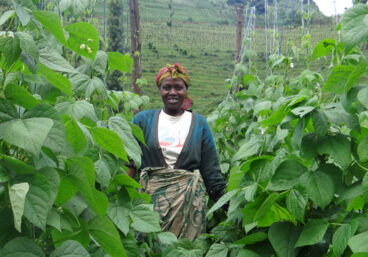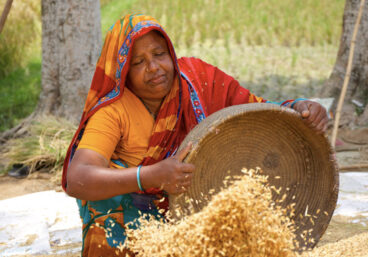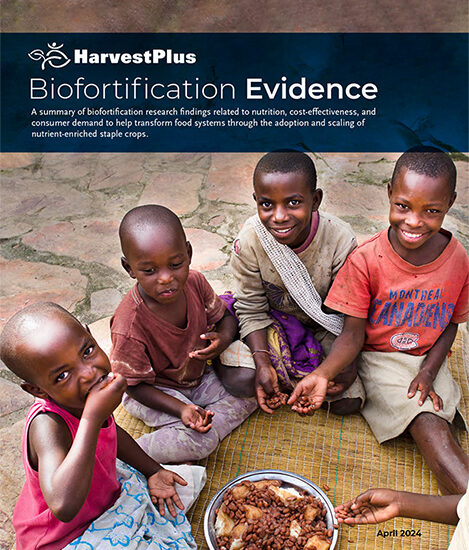Biofortified crops developed and promoted by HarvestPlus and its partners are backed by 20-plus years of peer-reviewed, published research on their nutrition and health benefits, cost-effectiveness, farmer adoption, and consumer acceptance.
Contact our research experts
Key high-level research findings:
Biofortified crops improve nutritional status and health when consumed as a regular part of daily diets.
Farmers are willing to grow biofortified crops because they are also high-yielding, contain several improved production traits, and are overall climate-adaptive.
Consumers prefer biofortified crops over comparable non-biofortified varieties (based on appearance, odor, taste, and texture); consumer acceptance (measured by willingness to pay) increases when consumers receive information on the nutritional benefits.

Rwandan Biofortified Bean Farmers Prosper From Greater Yields and Income
Smallholder farmers in Rwanda are challenged by low farm productivity, a reality compounded by the impacts of climate change, population growth, and other crises. To help address food and nutrition insecurity among the country’s most vulnerable communities, it is vital that solutions that increase farmers’ crop productivity, livelihoods, and household nutrition are implemented. Beans are […]

Preventing and Controlling Zinc Deficiency Across the Life Course: A Call to Action
New research has expanded the relevance of zinc deficiency across the life course. Zinc deficiency is well known for its impact on child growth and resistance to infections. Now, growing evidence shows it is also a key player in the emergent global burden of diabetes and cardiovascular disease in adulthood. A recent narrative review published […]

Potential Impact of Zinc-enriched Rice on Zinc Intakes in Bangladesh, Indonesia, and the Philippines
Populations across South, East, and Southeast Asia, where rice is the main staple food, have some of the highest estimated prevalences of inadequate zinc intake in the world. While rice provides ample energy and a base intake of many minerals and vitamins, it doesn’t provide zinc at levels high enough for optimal health—restricting growth, immune […]

Biofortification Research Evidence Brief
A summary of nutrition, health, and socio-economic research findings about biofortified crops.
Learn moreEvidence on Cost-Effectiveness
The Copenhagen Consensus, a leading global development think tank, ranks biofortification (and other interventions that reduce micronutrient deficiencies) among the highest value-for-money investments for economic development: For every USD invested in biofortification, they estimate as much as 17 USD of benefits gained.
Ex-ante (before intervention) analyses of several micronutrient-crop and country scenarios, as well as a recent systematic review of such analyses, have shown that biofortification is highly cost-effective when measured by the World Bank’s criteria of cost (in USD) per Disability-Adjusted Life Year (DALY) saved. These analyses show biofortified crops to be in the range of USD 15-20 per DALY save—far below the World Bank’s cost-effectiveness threshold of USD 270 per DALY.
HarvestPlus also developed the Biofortification Priority Index to inform strategies on biofortification research and development, to help identify countries where biofortification investments in 13 different crops are likely to have the greatest impact on reducing micronutrient deficiencies. For each crop, the BPI applies an impact potential ranking system among 128 countries of the Global South.
Evidence on Nutrition and Health Benefits
For each crop, evaluations of intrinsic nutritional value and potential impacts on human nutrition and health status are conducted in studies involving children, adolescents, and/or women. These are the primary target groups for biofortification, given their relatively high nutritional needs, which leave them more vulnerable to micronutrient deficiency.
How these benefits are assessed
Nutrient Retention Studies
What is the effect of typical processing (e.g. milling into flour), storage (e.g. in plastic bags), and cooking (e.g. boiling, baking, or frying) on the micronutrient content of crops?
Bioavailability and Absorption Studies
How much of the nutrients in consumed biofortified foods are taken up and used by the body?
Efficacy Studies
Do the micronutrients added by biofortification measurably improve nutrition and/or health compared to conventional counterparts in optimal (controlled) conditions over the short-term (3-9 months)?
Effectiveness Studies
Are the added micronutrients in biofortified foods enough to measurably improve nutrition and/or health compared to the conventional counterpart in free-living or typical market conditions over the long-term?
Published, peer-reviewed studies have shown that young children (1-6 years) and non-pregnant, non-lactating women of reproductive age (15-49 years) who consume biofortified crops as a main part of their diets can receive:
Proven health benefits
Evidence on Farmer Adoption
Researchers conduct farmer field day evaluations, outcome monitoring surveys, nationally representative varietal adoption studies, and randomized control studies to understand farmers’ adoption of biofortified crops. Studies show in particularly that biofortified crops’ competitive agronomic traits—including high yield, fast maturation, and disease- and drought-resistance—drive adoption by farmers.
What do the numbers show?
The first biofortified staple crop varieties were provided to farmers in 2004—vitamin A orange sweet potato varieties in Mozambique and Madagascar. As of the end of 2021, an estimated 12.8 million smallholder farming families were growing biofortified crops, compared to 1.7 million in 2014.
See the Global Reach page for breakdowns by country.
Selected Farmer Adoption Studies
Iron Beans in Rwanda
A nationally representative survey of bean producing households showed iron beans were nearly 12 percent of national bean production, only four years after delivery of iron beans to farmers had begun.
View the studyVitamin A Orange Sweet Potato in Mozambique and Uganda
A randomized controlled trial found high adoption rates (over 60 percent) among participating householders, while a follow up study in 2012 showed sustained high adoption and consumption.
View the studyVitamin A Cassava in Nigeria
An outcome monitoring survey in four states showed 21 percent of cassava acreage was allocated to vitamin A cassava (VAC), and VAC roots were 25 percent of cassava production, suggesting a favorable yield advantage.
View the StudyEvidence on Consumer Acceptance
Researchers conduct consumer acceptance studies in the field and in lab conditions to understand consumers’ acceptance—expressed in terms of their willingness to pay or sensory (organoleptic) evaluations, or both —for biofortified foods.
Iron Pearl Millet in India
Consumers liked bhakri (flat bread) made with iron pearl millet (IPM) as much or more than bhakri made with non-biofortified pearl millet. Preference for IPM bhakri increased when nutrition information was also provided.
View the studyVitamin A Maize in Zambia
Consumers accorded higher value (measured as willingness to pay) to nshima (thick corn porridge) made with vitamin A orange maize (VAM) than to nshima made with white or yellow maize. VAM preference increased when nutrition information was also provided.
View the studyIron Bean in Rwanda
Consumers preferred a red iron bean variety over a white iron bean variety or a non-biofortified popular variety when no nutritional information was provided; with nutritional information, both iron bean varieties were preferred over the non-biofortified variety.
View the study